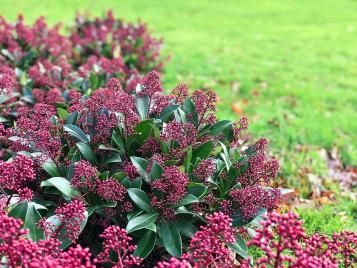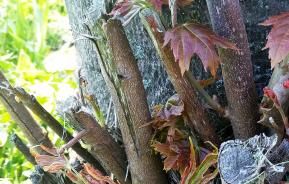Skimmias are evergreen shrubs that are extremely valuable for their multi-season displays – especially in winter. Their glossy evergreen leaves provide a lovely contrast to their fragrant white or yellowish flowers in April and May and long-lasting winter berries.
Most Skimmia varieties are either male or female which means that to develop berries a female plant will need a male nearby to pollinate it. There are some hermaphrodite self-fertile varieties which do not need a partner but even these will produce more fruit if a male is grown close by.
Skimmia japonica Rubella is a good choice for a male partner as it is most attractive with lovely dark red flower buds in winter that become pretty little white scented flowers in early spring.
How to grow skimmias
Skimmia prefer a position in shade and can even tolerate positions in deep shade. Definitely avoid planting in full sun as it can cause the leaves to turn yellow.
Skimmia plants prefer neutral soils. They will grow in alkaline/limey soils (except those on solid chalk) providing it contains lots of organic matter such as compost, leafmould, composted bark or well-rotted manure.
Skimmia are perfect for growing in containers of John Innes Compost No. 3 and it is better to do this if your soil is very chalky.
Skimmia varieties
- Skimmia x confusa Kew Green (Male)
- Skimmia japonica Fragrans (Male)
- Skimmia japonica Nymans (Female)
- Skimmia japonica subsp. Reevesiana (Self fertile)
- Skimmia japonica Rubella (Male)
- Skimmia japonica Temptation (Self fertile)
- Skimmia japonica Veitchii (Female) Sometimes still sold under its old name ‘Foremanii’.

Suggested planting locations and garden types for skimmias
Flower borders and beds, patios, containers, city and courtyard gardens, cottage and informal gardens, woodland gardens. Avoid areas which are in full sun or become water logged.
Planting skimmias
Skimmia can be planted at just about any time of year but avoid planting when the soil is frozen solid, waterlogged or extremely dry.
Be wary of very pot bound plants, especially those that have been ‘forced’ into producing berries, as they usually take a long time to establish. They often don’t establish well when planted out.
Dig over the planting area incorporating lots of organic matter such as compost, leafmould or well-rotted manure. Dig a good sized hole big enough to easily accommodate the rootball.
Place the rootball in the planting hole and adjust the planting depth so that it is planted at the same depth as it was originally growing and the top of the rootball is level with the soil surface.
Mix in more organic matter with the excavated soil and fill in the planting hole.
Water in well, apply a granular general feed over the soil around the plant and add a 5-7.5cm (2-3in) deep mulch of well-rotted garden compost or bark chippings around the root area.
How to care for skimmias
Skimmia are very easy to look after and rarely need much in the way of care and attention once established.
Water skimmias them well in the first year while they are establishing. After that plants in the ground may need watering during prolonged periods of very dry weather or more often if the soil is very light and very well drained.
Feed in spring with a balanced granular plant food. Those suitable for Camellias and Rhododendrons are a good choice in alkaline soils.
Mulch around plants in spring with a 5-7.5cm (2-3in) thick layer of organic matter such as compost, composted bark or well-rotted manure. Make sure the mulch is kept clear of the base of the stems.
Plants rarely need any pruning but if needed it should be carried out in spring after flowering has finished. Remove unwanted stems cutting back well inside the leaf canopy to hide the cut ends. Pruning will prevent female varieties from producing berries the following winter.
| Flowering season(s) | Spring with berries lasting throughout autumn/winter |
|---|---|
| Foliage season(s) | Spring, Summer, Autumn, Winter |
| Sunlight | Full shade, Partial shade |
| Soil type | Loamy, Sandy |
| Soil pH | Neutral, slightly acid loving |
| Soil moisture | Moist but well-drained |
| Ultimate height | Up to 1.2m (4ft) |
| Ultimate spread | Up to 1.2m (4ft) |
| Time to ultimate height | 5-7 years |








